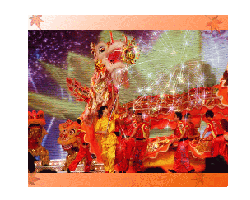
Dragon Dance is a form of traditional
dance and performance in Chinese culture. It is often seen in
festival celebrations. The dance team mimics the supposed movements of Dragon in a sinuous, undulating
manner.
The movements in a performance traditionally symbolize historical
roles of dragons demonstrating power and dignity. The dragon dance is a highlight of Chinese New Yes celebrations held by Chinese
worldwide because dragons are believed to bring good luck to
people.
|
 |
|
The common length and size of the body for the dragon is 12 feet (34
meters) and is divided into 9 major sections. The size and length so a dragon depend on the human power available, financial power,
materials, skills and size of the field. It's length ranges from 9
sections to 15 sections long, though some are as long as 46 sections.
There are three main parts in a dragon: head, body, and tail. To be
successful in the dance, the head of the Dragon must be able to cooperate with the body in combination with the timing of the drum. For
larger ceremonial and parade style dragons, the head can weigh as much as 32 lb (almost 14.4 kg). The dragon tail also plays an important
role as it will have to keep in time with head movements.
The dragon dance is performed in various ways, types and colors.
For example, the following list is about the symbolization of
different dragon colors:
|
color |
representing |
|
green |
great harvest |
|
yellow |
the solemn empire, |
|
golden or silver |
prosperity |
|
red |
excitement |
The dragon's scales and tail are mostly beautiful silver colors and
glittering at all times which provides a feeling of joyous
atmosphere.
The patterns of the dragon dance are
well designed according to the skills and experiences of the
performers. Some of the patterns of the dragon dance are “Cloud Cave”, “Whirlpool”, “Tai chi
pattern”, “Threading the money”, “Looking for pearl”, and “dragon encircling the pillar.” The basic skills of performing in a dragon dance
are simple to learn, however to become a competent performer takes dedicated training until movements become second nature and complex
formations can be achieved.
|